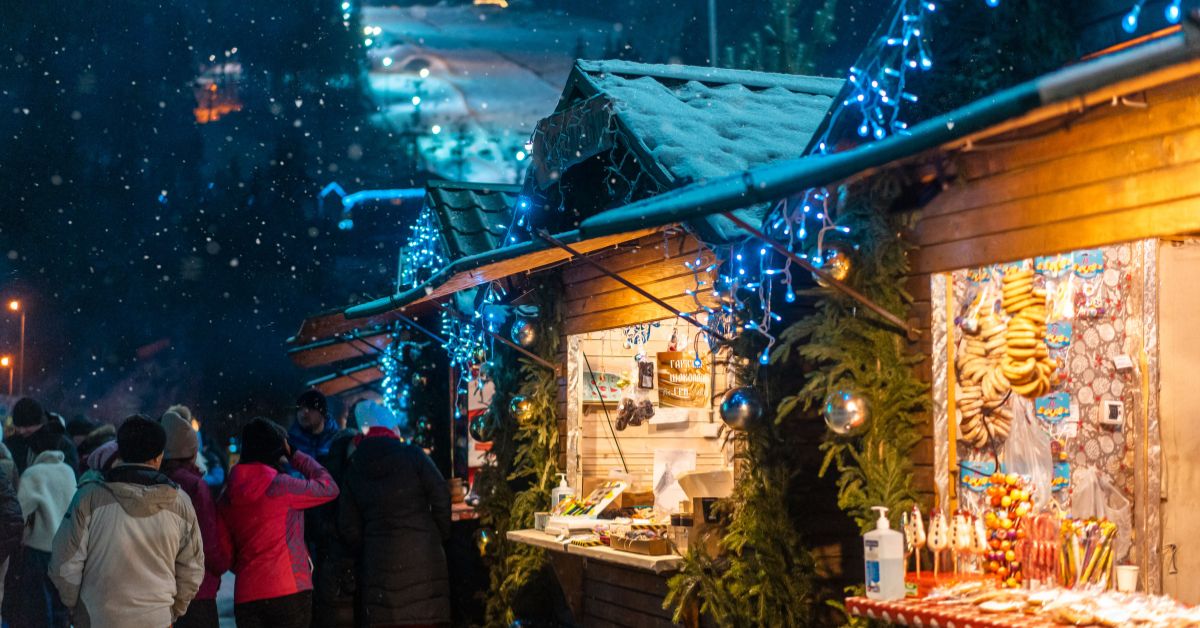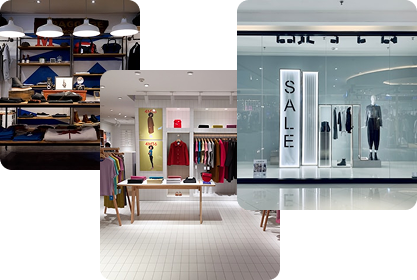You can run a winter pop-up in Canada. Many brands do it. The trick is to know the upside, the downside, and the parts that get messy in the cold. This guide stays practical. It leans on real rules and real conditions. It uses the exact phrase “Pros & Cons of Running a Pop-up in Canadian Winters” because some of you asked for that. Let’s get into it.
Quick context that affects every winter pop-up
- Holiday demand lifts in-store sales. Canadian retail sales rose into the 2024 holiday period. SpendingPulse projected a 2.2% year-over-year rise for Nov–Dec 2024, with in-store shopping expected to outpace online. That can help a pop-up on a busy block or inside a mall.
- Seasonal retail stayed resilient at year-end. StatCan reported total 2024 retail sales at $803.1B, up 1.3% from 2023, with a solid December finish. Clothing and footwear saw December gains year-over-year.
- Cold and wind matter. Frostbite can set in within minutes on exposed skin under strong wind chill. That shapes line management and staffing breaks.
- Shorter days. Canada’s darkest stretch sits around the Dec solstice. Earlier sunsets cut casual evening foot traffic outdoors, which nudges many brands toward indoor venues or enclosed walkways.
- Heaters and tents have strict rules. Patio heaters are for outdoor use. Never use them inside an enclosed tent because of carbon monoxide risk. Permits and certifications apply and vary by city and province.
Pros
1) Peak gift season, real-world intent
If your offer fits gifting, cold months can work in your favour. National spending lifted into the 2024 holidays, and apparel saw a clear December bump. A well-placed pop-up can ride that wave, perhaps more than a web-only push.
2) Indoor venues and enclosed paths pull steady footfall
Many downtowns route shoppers through enclosed walkways and underground paths to avoid the cold. Setting up inside those systems or in mall corridors keeps traffic more stable than a street-only spot.
3) Space owners may welcome short terms
Some landlords prefer activation over sitting dark in winter. Short terms can fit their needs. You still need to read the fine print, carry proper insurance, and align on permits. Toronto Metropolitan University’s pop-up legal notes are a helpful primer on lease terms and coverage.
4) Clear, time-boxed story
“Here for the season” can spark action. Holiday SKUs, limited runs, or a “warm-up bar” for try-ons can draw quick decisions. No airy promises here. It works when the product and the moment line up.
Cons
1) Safety and liability climb
Snow and ice raise slip-and-fall risk outside and at the door. Claims fall under occupier’s liability. You need strong floor mats, grit, clear shoveling plans, and active logs. Your CGL policy is the baseline.
2) Heating rules, permits, and real cost
Patio heaters are outdoor devices. Do not run them inside an enclosed tent or structure. Use CSA/ULC-certified equipment. In BC, temporary gas heaters require Technical Safety BC certification. Cities like Vancouver list allowed heater types on patios and may require separate electrical or gas permits.
3) Tent thresholds trigger building and fire steps
In Ontario, tents or groups of tents at or above 60 m² often require a building permit, with added engineer review beyond certain sizes. Fees apply in Toronto. Many municipalities echo the 60 m² line. If food is involved, provincial event food rules can kick in.
4) Shorter daylight and bitter nights
Earlier sunset reduces casual evening browsing outdoors. If your shop lives on street footfall, that hurts. Night openings can work inside malls or covered routes. Outdoors, it gets harder.
5) Staff comfort and turnover risk
Wind chill adds real danger for greeters or outdoor lines. Plan frequent warm breaks and a heated back-of-house. Skip this and you burn out your team.
What works best in Canadian winters
Pick the right box
- Street-level, but truly “winter-ready.” Wide entrance mats with grit control, staff assigned to clear snow, and bright entry lighting for early sunsets. Use salt best practices to avoid over-salting that turns floors messy.
Choose heater types with care
- Outdoor patios or open-air frontage: Use certified outdoor heaters only. Keep fuel cylinders outside and secured. Never inside a tent.
- BC setups: Temporary gas heaters need Technical Safety BC certification.
- Vancouver patios: Portable propane allowed. Hardwired electric or plumbed gas need extra permits.
Know the tent line
- Ontario’s common trigger is 60 m² aggregate ground area. At or above that, expect a permit. Close spacing to buildings or other tents can also trigger permits. Budget the fee and lead time.
Mind the door and the floor
- Keep the entrance dry and grippy. Use mats that reach past the swing arc. Keep a sand or grit bucket on hand. This is not “nice to have.” It protects people and your insurance record.
Plan for short days
- Shift hours earlier, for example 11–7, if you live on walk-up traffic. Extend evenings only in indoor or enclosed settings.
Set a cold-weather SOP
- Define when you shorten hours during extreme cold alerts. Document warm breaks. Keep a small stock of hand warmers for staff. Environment and Climate Change Canada’s guidance is clear about the frostbite window in strong wind chill.
Province-level notes you should check early
- Ontario: Building Code tent threshold often 60 m². Toronto lists permit fees for certified and non-certified tents. Ontario’s Fire Code and propane rules also apply.
- British Columbia: Technical Safety BC sets rules for temporary gas heaters. Check local patio programs for heater types and added permits.
- Food vendors: Temporary events have specific food-safety steps. Nova Scotia’s guideline is a good example of the kind of checks you will face. Other provinces publish similar sheets.
A simple winter pop-up playbook
1) Pick the site
Start with indoor or enclosed options near transit. If outdoors, pick a sun-exposed frontage, wide sidewalk, and room for mats and snow storage. The closer you sit to a covered walkway, the better.
2) Lock the legal basics
Ask the landlord for their winter maintenance plan. Shovel, salt, and logs. Add your CGL proof. Confirm any tent size and spacing. If you cross the 60 m² line in Ontario, file the permit.
3) Heating and power
Choose certified heaters that match the space type. Outdoor device outdoors. Keep cylinders outside and secured. For electric, plan load with a licensed pro and the venue. Vancouver’s rules show how cities split propane vs electric vs plumbed gas.
4) Entrance and floors
Lay long, absorbent mats. Keep grit at hand. Swap wet mats fast. Photograph your cleaning log. It helps if a claim lands.
5) Hours and staffing
Open earlier on short-day months. Rotate warm breaks. During extreme cold alerts, scale back outdoor exposure.
6) Merch and CX
Keep try-on zones warm and bright. Offer quick checkout. If a queue forms outside, move it inside the vestibule or set a timed return system. Cold fingers leave fast.
7) Supply and weather
Storm days hit deliveries. Stock key sizes deeper. Keep a one-page closure plan for your socials and Google Business Profile.
Pros & Cons of Running a Pop-up in Canadian Winters, at a glance
Pros
- Holiday demand and in-store intent peak.
- Enclosed routes and malls keep traffic moving.
- Short terms can fit landlord needs if your paperwork is clean.
Cons
- Slip-and-fall exposure rises, and claims follow sloppy logs.
- Permits and certifications add time. Ontario’s 60 m² tent line is common.
- Short days and extreme cold reduce outdoor browsing.
A short checklist you can copy
- Venue chosen. Indoor, enclosed, or outdoor with clear snow room.
- Lease signed. CGL in place. Maintenance plan in writing.
- Tent math done. If Ontario and ≥ 60 m² total, file permit.
- Heaters selected. Certified. Outdoors for outdoor devices. Fuel stored outside and secured.
- Entrance ready. Long mats, grit bucket, wet-floor signs, photo log.
- Hours set for short days. Staff warm-break schedule posted.
Why this piece stands apart from PopupTogether’s current posts
PopupTogether’s blog covers platform match-making, benefits of pop-ups, and AI’s role in short-term retail. This article stays on winter-specific operations, permits, heater rules, and cold-weather safety that affect a pop-up day to day. Different topic, deeper on winter.




